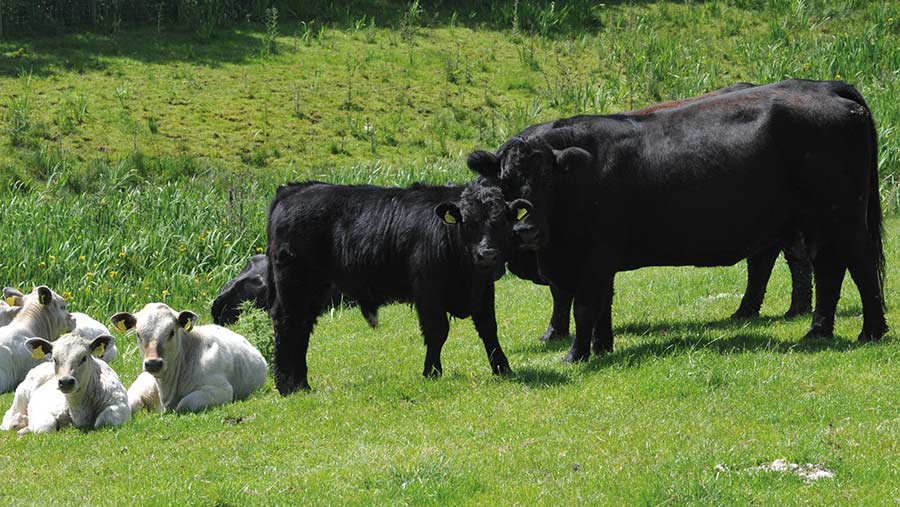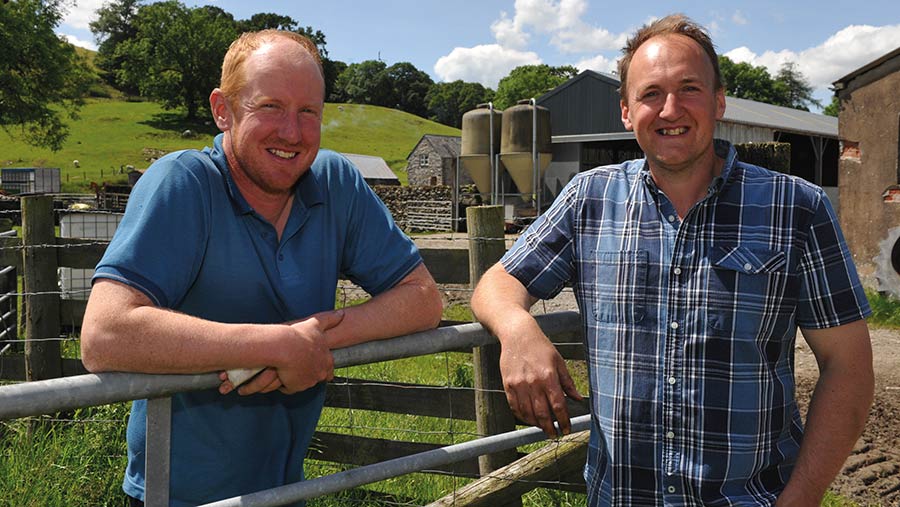How heat detection kit helps cut calving interval by 25 days
 © Debbie James
© Debbie James A Welsh suckler beef herd’s calving interval has been shortened by 25 days, to 367 days, since measures including the use of heat-detection technology were introduced to improve fertility.
Sub-fertility in two stock bulls at Fferm Rhiwaedog, near Bala, had resulted in a calving period that ran from February to October, says Dylan Jones, who farms with his father and brother, Emyr and Aled.
“This caused problems with managing calving and with grouping stores for sale,” he recalls.
See also: How rumen boluses can help manage suckler cow fertility
In addition, the calving interval had extended to 392 days.
Farm facts: Fferm Rhiwaedog, Gwynedd
- 142ha (351 acres) upland farm; 121ha (299 acres) rented on a nearby holding
- 80 mostly pedigree Welsh Black cows
- Half the herd crossed with Welsh Black to breed herd replacements and the other half to a Charolais
- Beef progeny sold as stores at 12-18 months at livestock markets
- Flock of 1,400 ewes: Texel cross Mules and Aberfields, Cheviot cross Welsh ewes, and Welsh ewes
- All lambs sold through the live trade
Breeding alerts
Through its work as a Farming Connect demonstration farm, the business introduced measures to reduce the calving period.
These included fitting heat-detection collars on its two Welsh Black and Charolais stock bulls, and tags to the cows, both of which issue alerts of breeding activity.
In 2021, this measure, in combination with pre-calving checks, resulted in a shorter calving period, from March to September, and with 84% of cows calving in the first four months. Just 5% calved in August and 4% in September.
Mr Jones says the technology has been invaluable in promptly flagging up when cows have not been served. This is especially the case when a new bull is being used.
“It means we can do something about it instead of waiting until the day of scanning – in the past that could have meant three months lost. It gives us peace of mind that the bull is doing his job,” he explains.
“Before we used the collars we would have no idea until the day of scanning how many animals would be in calf, or how many would not.”
Cows that have not conceived are given a veterinary investigation and, if appropriate, ovulation is synchronised with CIDRs (progesterone-releasing intra-uterine devices).
Of the four animals that had CIDRs inserted in the 2021 breeding period, only one had repeated.

Dylan Jones (left) and Aled Jones at Fferm Rhiwaedog © Debbie James
Fertility issues
Vet Joe Angell, of Wern Vets, who is working with the Joneses on the project, says issues commonly seen in cows pre-breeding include endometritis, ovarian cysts and dormant ovaries.
“If there is a problem with a cow that we want to address, this technology means we can identify that problem earlier and deal with it,” says Dr Angell.
Post-calving checks are carried out as routine in Rhiwaedog’s herd of mainly Welsh Black cattle.
“Sometimes, if a cow has had a difficult calving or has given birth to twins, she may have an infection in the reproductive tract,” Dr Angell says.
“Cows are now checked after they have calved to make sure they haven’t got an infection and they are suitable to go to the bull.”
Cost
The heat detection technology in use at Rhiwaedog costs £1,095 ex VAT for one collar and 50 tags, plus a £255 annual fee to keep the system connected to the mobile phone network.
Tags cannot be reused as each contains a microchip with an ID assigned to a single cow.
The technology was again used in the 2021 breeding season and has resulted in the predicted calving period being shifted further. It began in February and will run through to August, with pregnancy diagnosis showing that nearly half the herd – 35 cows – would calve in May.
Because of limited housing, Mr Jones says the business wants only a third to calve in February and March; the target is to get to a point where the remaining two thirds calve in May and June.
Calving interval
In 2022, the expected calving interval will show a slight increase on 367 days, a little over the beef industry target for calving interval of 365 days.
This is because a few cows – animals with good pedigree lines which had calved at the back end of 2020 – were not bulled in the following spring, to get them back in sync with the preferred calving period.
Dr Angell says having a compact calving pattern has multiple benefits, not least improving beef herd efficiency and the consequential likelihood of higher profitability.
“When a calving interval is extended, that cow becomes a cost to the business, and the longer the gap between calvings, the harder it is to get her in calf,” he says.
There is also a greater chance that the animal will become too fat and experience difficulties at calving.
There are major business and welfare benefits to cows being managed at the right stage, and calves have better health if they are managed at the correct stage too, Dr Angell adds.
Challenges
But the use of collars is not without its challenges.
Mr Jones reports issues with cows losing their tags. “When that happens we don’t know whether the cow is bulling or not – that is something we have to be aware of.
“It is not that much of a problem in the summer, but we have noticed cows are more likely to lose their tags in the winter.”
